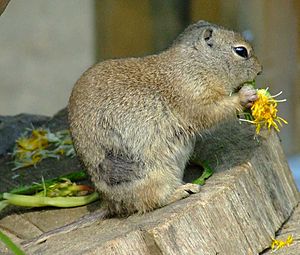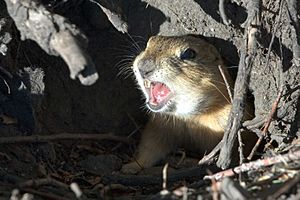Richardson's ground squirrel facts for kids
Quick facts for kids Richardson's ground squirrel |
|
|---|---|
 |
|
| Conservation status | |
| Scientific classification | |
| Genus: |
Urocitellus
|
| Species: |
richardsonii
|
 |
|
| Synonyms | |
|
Spermophilus richardsonii |
|
The Richardson's ground squirrel (Urocitellus richardsonii) is a small animal found in North America. People also call it the dakrat or flickertail. It is a type of ground squirrel. Sometimes, these squirrels are mistakenly called prairie dogs or pocket gophers, but those are different animals.
Contents
About the Richardson's Ground Squirrel
This squirrel got its name from Sir John Richardson, a Scottish scientist. The state of North Dakota is even nicknamed the "Flickertail state" because of this squirrel! The name "Dakrat" comes from "Dakota Rat" and is often used in places like Minot, North Dakota.
Where Richardson's Ground Squirrels Live
These squirrels originally lived in short grass prairies. You can find them in the northern parts of the United States, like North Dakota and Montana. They also live in western Canada, including parts of Alberta and Saskatchewan.
Their home range grew bigger as forests were cut down to make farms. They don't just live in prairies anymore. Sometimes, they move into suburban areas. Here, they might be seen as pests because they dig burrows under sidewalks and patios.
What Richardson's Ground Squirrels Look Like
Adult squirrels are usually about 30 centimetres (12 in) long. Their weight changes a lot during the year. When they first come out of hibernation, females weigh around 200 and 275 g (0.441–0.606 lb). Males are a bit heavier, weighing between 350 and 450 g (0.77–0.99 lb). Before they hibernate again, they can weigh almost 750 grams (1.65 lb)!
Males are a little bigger and heavier than females. Their fur is dark brown on top and tan underneath. They have a shorter, less bushy tail than other ground squirrels. Their ears are so small they look like holes on their head. Their tail often trembles, which is why they are called "flickertails."
In the wild, males usually live for about 3 years, and females live for about 4 years. Some squirrels in captivity have lived for 5 to 7 years.
How Richardson's Ground Squirrels Behave
Richardson's ground squirrels seem to live together in groups. However, their social groups are mostly made up of related females. A female squirrel will let her close relatives be near her. But she will protect her space from other squirrels that are not related to her.
Their burrows are often close together in large groups called colonies. When a predator comes near, the squirrels make loud alarm calls. Scientists have found that they sometimes even use sounds that humans can't hear (called ultrasonic calls) to warn each other.
Richardson's ground squirrels have two main alarm calls you can hear. A high-pitched whistle warns about predators on the ground, like coyotes. A 'chirp' call warns about predators from the air, like hawks. Other animals that hunt them include owls, snakes, weasels, and badgers.
What Richardson's Ground Squirrels Eat

These animals are omnivores, which means they eat both plants and animals. They enjoy eating seeds, nuts, grains, grasses, and insects.
Hibernation and Life Cycle
Adult ground squirrels can start their hibernation as early as July. However, young squirrels born that year don't hibernate until September. The males come out of hibernation in March. They set up their territories before the females appear a few weeks later. Sometimes, other grassland animals, like the burrowing owl, will use burrows that the squirrels have left.
Reproduction and Life Cycle
Female Richardson's ground squirrels have one group of babies each year. On average, they have 6 babies, but they can have up to 14! The young squirrels are born in April or May.
The baby squirrels stay underground in their burrow for about 30 days. They come out of their birth burrows in late May to mid-June. When they first appear, they weigh about 50 to 100 grams.
Richardson's Ground Squirrels and People
Because these squirrels eat crops, farmers sometimes see them as pests. However, they are not legally considered pests everywhere. In 2010, the government of Saskatchewan in Canada said they were pests. This allowed local governments to take steps to control their numbers. In areas where there are not many natural predators, too many squirrels can cause them to move into neighborhoods.
Controlling Squirrel Numbers
Farmers and ranchers use different ways to control ground squirrels, like trapping or shooting them. Sometimes, they try to reduce the squirrel population in other ways. Even if these methods work, squirrels from other areas can eventually move back in.
The Saskatoon Wildlife Federation once held a "gopher derby" to reduce the number of squirrels. People won prizes for killing the most squirrels. However, animal welfare groups said the contest was cruel. The contest was stopped after a few years when the squirrel population went down.
Richardson's Ground Squirrels as Pets
In recent years, Richardson's ground squirrels have become popular as exotic pets.
See also
 In Spanish: Ardilla terrestre de Richardson para niños
In Spanish: Ardilla terrestre de Richardson para niños





